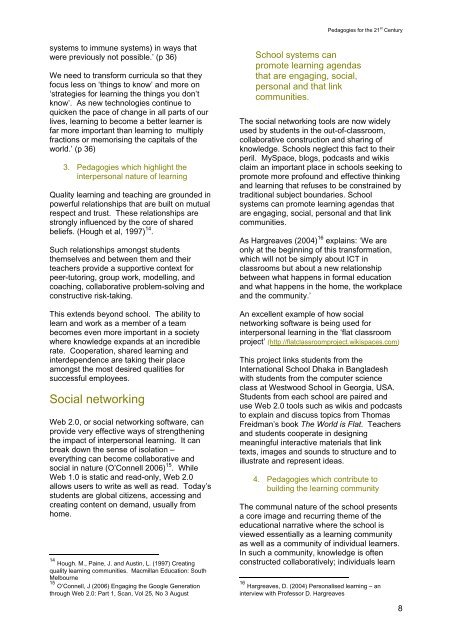pedagogies-for-the-21st-century
pedagogies-for-the-21st-century
pedagogies-for-the-21st-century
You also want an ePaper? Increase the reach of your titles
YUMPU automatically turns print PDFs into web optimized ePapers that Google loves.
Pedagogies <strong>for</strong> <strong>the</strong> 21 st Century<br />
systems to immune systems) in ways that<br />
were previously not possible.’ (p 36)<br />
We need to trans<strong>for</strong>m curricula so that <strong>the</strong>y<br />
focus less on ‘things to know’ and more on<br />
‘strategies <strong>for</strong> learning <strong>the</strong> things you don’t<br />
know’. As new technologies continue to<br />
quicken <strong>the</strong> pace of change in all parts of our<br />
lives, learning to become a better learner is<br />
far more important than learning to multiply<br />
fractions or memorising <strong>the</strong> capitals of <strong>the</strong><br />
world.’ (p 36)<br />
3. Pedagogies which highlight <strong>the</strong><br />
interpersonal nature of learning<br />
Quality learning and teaching are grounded in<br />
powerful relationships that are built on mutual<br />
respect and trust. These relationships are<br />
strongly influenced by <strong>the</strong> core of shared<br />
beliefs. (Hough et al, 1997) 14 .<br />
Such relationships amongst students<br />
<strong>the</strong>mselves and between <strong>the</strong>m and <strong>the</strong>ir<br />
teachers provide a supportive context <strong>for</strong><br />
peer-tutoring, group work, modelling, and<br />
coaching, collaborative problem-solving and<br />
constructive risk-taking.<br />
This extends beyond school. The ability to<br />
learn and work as a member of a team<br />
becomes even more important in a society<br />
where knowledge expands at an incredible<br />
rate. Cooperation, shared learning and<br />
interdependence are taking <strong>the</strong>ir place<br />
amongst <strong>the</strong> most desired qualities <strong>for</strong><br />
successful employees.<br />
Social networking<br />
Web 2.0, or social networking software, can<br />
provide very effective ways of streng<strong>the</strong>ning<br />
<strong>the</strong> impact of interpersonal learning. It can<br />
break down <strong>the</strong> sense of isolation –<br />
everything can become collaborative and<br />
social in nature (O’Connell 2006) 15 . While<br />
Web 1.0 is static and read-only, Web 2.0<br />
allows users to write as well as read. Today’s<br />
students are global citizens, accessing and<br />
creating content on demand, usually from<br />
home.<br />
14 Hough. M., Paine, J. and Austin, L. (1997) Creating<br />
quality learning communities. Macmillan Education: South<br />
Melbourne<br />
15 O’Connell, J (2006) Engaging <strong>the</strong> Google Generation<br />
through Web 2.0: Part 1, Scan, Vol 25, No 3 August<br />
School systems can<br />
promote learning agendas<br />
that are engaging, social,<br />
personal and that link<br />
communities.<br />
The social networking tools are now widely<br />
used by students in <strong>the</strong> out-of-classroom,<br />
collaborative construction and sharing of<br />
knowledge. Schools neglect this fact to <strong>the</strong>ir<br />
peril. MySpace, blogs, podcasts and wikis<br />
claim an important place in schools seeking to<br />
promote more profound and effective thinking<br />
and learning that refuses to be constrained by<br />
traditional subject boundaries. School<br />
systems can promote learning agendas that<br />
are engaging, social, personal and that link<br />
communities.<br />
As Hargreaves (2004) 16 explains: ‘We are<br />
only at <strong>the</strong> beginning of this trans<strong>for</strong>mation,<br />
which will not be simply about ICT in<br />
classrooms but about a new relationship<br />
between what happens in <strong>for</strong>mal education<br />
and what happens in <strong>the</strong> home, <strong>the</strong> workplace<br />
and <strong>the</strong> community.’<br />
An excellent example of how social<br />
networking software is being used <strong>for</strong><br />
interpersonal learning in <strong>the</strong> ‘flat classroom<br />
project’ (http://flatclassroomproject.wikispaces.com)<br />
This project links students from <strong>the</strong><br />
International School Dhaka in Bangladesh<br />
with students from <strong>the</strong> computer science<br />
class at Westwood School in Georgia, USA.<br />
Students from each school are paired and<br />
use Web 2.0 tools such as wikis and podcasts<br />
to explain and discuss topics from Thomas<br />
Freidman’s book The World is Flat. Teachers<br />
and students cooperate in designing<br />
meaningful interactive materials that link<br />
texts, images and sounds to structure and to<br />
illustrate and represent ideas.<br />
4. Pedagogies which contribute to<br />
building <strong>the</strong> learning community<br />
The communal nature of <strong>the</strong> school presents<br />
a core image and recurring <strong>the</strong>me of <strong>the</strong><br />
educational narrative where <strong>the</strong> school is<br />
viewed essentially as a learning community<br />
as well as a community of individual learners.<br />
In such a community, knowledge is often<br />
constructed collaboratively; individuals learn<br />
16 Hargreaves, D. (2004) Personalised learning – an<br />
interview with Professor D. Hargreaves<br />
8


